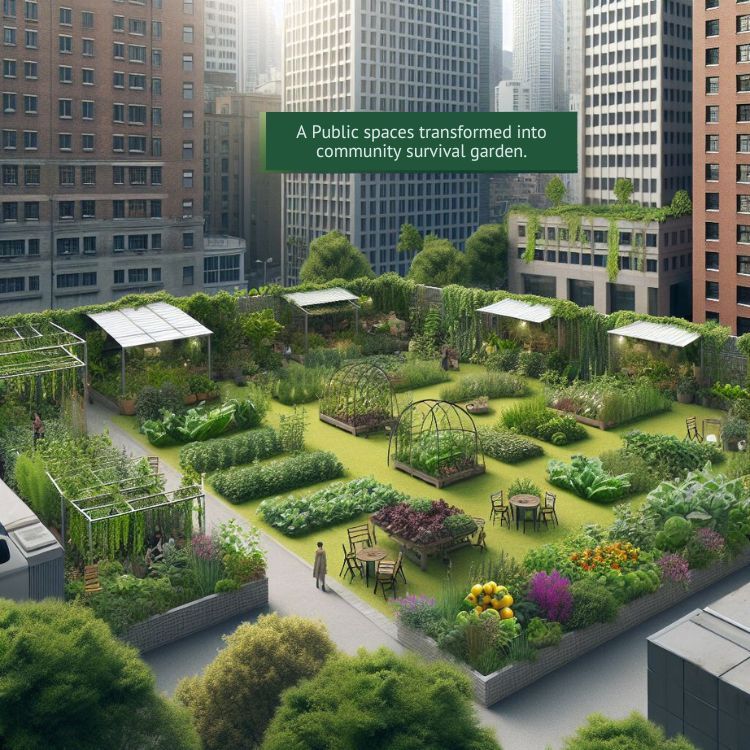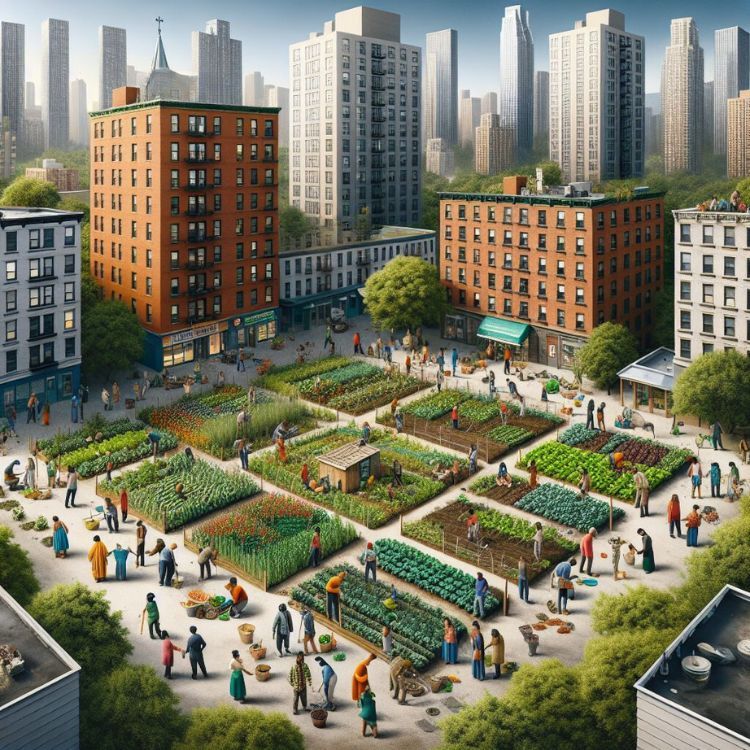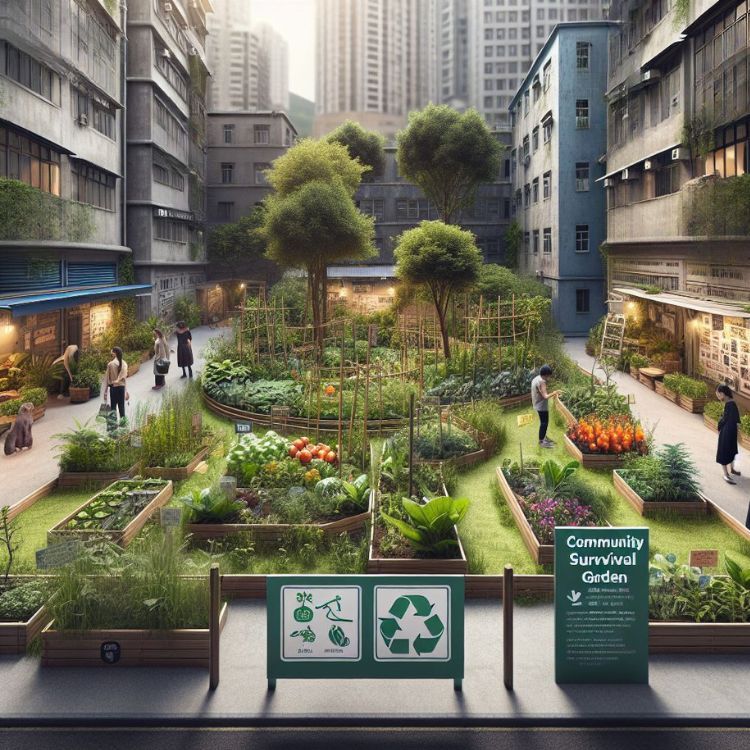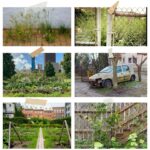
Article-at-a-Glance
-
Community survival gardens transform underused urban spaces into productive green areas.
-
Pocket parks can boost neighborhood spirit and enhance food security.
-
Starting your own community garden involves securing permissions, organizing the community, and careful planning.
-
Educational opportunities arise from urban agriculture, fostering a sustainable ecosystem.
-
Practical tips for starting a community survival garden are provided, including how to maintain it with limited resources.
Why Pocket Park Produce is a Game Changer
Imagine a city where every empty lot, every little unused space, is turned into a thriving garden, overflowing with vegetables and fruits. This isn’t a far-fetched dream—it’s the growing reality of community survival gardens. These gardens are more than just patches of greenery; they’re powerful tools for building resilience within urban communities, providing fresh produce, and bringing people together.
What Are Community Survival Gardens?
At their core, community survival gardens are shared spaces where people come together to grow food. They’re about self-reliance, sustainability, and resilience. In times of economic hardship or supply chain disruptions, these gardens can be a lifeline, offering fresh, nutritious food when it’s needed most.
But community survival gardens are not just about survival in the face of adversity. They’re about thriving together, teaching valuable skills, and fostering connections among neighbors. In a world that’s increasingly digital and disconnected, these gardens bring us back to the earth—and to each other.
Understanding Pocket Parks
Pocket parks are small oases in urban landscapes. They’re often tucked away in unexpected places—between buildings, alongside parking lots, or at the end of residential streets. Despite their size, they pack a punch when it comes to benefits. They’re not just for leisure; they’re potential hotbeds for urban agriculture.
Most importantly, pocket parks have the power to transform neighborhoods. They can turn neglected areas into vibrant community hubs. And when it comes to community survival gardens, they’re the perfect setting. They offer a way to utilize every square inch of our cities for good.
Did you know? A study from the University of California Cooperative Extension found that community gardens can increase fruit and vegetable intake among gardeners and their families, leading to better overall health.
The Heart of Community Revival

When you plant seeds in a community survival garden, you’re planting more than just food. You’re planting the seeds of community spirit and togetherness. This is why community survival gardens are at the heart of urban revival—they’re spaces where people from all walks of life can come together for a common purpose.
Boosting Neighborhood Spirit
Community gardens have a unique way of knitting a neighborhood together. They become meeting places where people share not just tools and tasks, but stories and support. They foster a sense of belonging and collective ownership. Everyone has a stake in the garden’s success, and that shared investment can lift up an entire community.
Enhancing Food Security
In a world where food deserts—areas without easy access to fresh, healthy food—are all too common in cities, community survival gardens offer a solution. They provide access to food that’s not only fresh but also free or low-cost. This is critical for families facing food insecurity, and it’s a powerful way to take control of one’s own nutrition and well-being.
From Wasted Space to Green Grace
There’s something incredibly satisfying about watching a once-empty lot bloom with life. Transforming these spaces into productive gardens isn’t just aesthetically pleasing—it’s a practical use of land that might otherwise go to waste. But how do we identify the right spots for these gardens?
Identifying Ideal Locations
When scouting for potential garden sites, look for spaces that get plenty of sunlight, have access to water, and are visible to the community. Visibility not only helps with security but also invites curiosity and participation. And don’t overlook the less obvious places—rooftops, alleyways, even parking strips can be garden goldmines.
Design Principles for Maximum Yield
To get the most out of a small space, smart design is key. Raised beds can help improve drainage and soil quality. Vertical gardening techniques like trellises and hanging planters maximize space. And companion planting—where different crops are planted together for mutual benefit—can help deter pests and diseases naturally.
Remember, the layout of your garden should encourage community interaction. Include pathways for easy access, and consider communal spaces like a picnic table or bench where people can gather and enjoy the garden’s bounty together.
Identifying Ideal Locations
Let’s start with the basics: finding the right spot for a community survival garden. You want a place that’s accessible, visible, and has plenty of sunlight. It should be a spot that feels welcoming, where the soil is rich or can be enriched, and where water is readily available. Think about underutilized spaces such as empty lots, rooftops, or even wide medians on boulevards. These places are often overlooked, yet they hold the potential to become the heart of the community.
Design Principles for Maximum Yield
Designing a garden for maximum yield requires a blend of creativity and practicality. Start with raised beds to optimize drainage and soil quality. Incorporate vertical structures like trellises for climbing plants, which not only save space but can also create a lush, green backdrop. Diversify the crops to ensure a continuous harvest and use companion planting to naturally repel pests and encourage pollination. Most importantly, design your garden to be a welcoming place that encourages community participation and interaction.
Growing Together: How to Start Your Own Pocket Park Produce

To start a community garden, you’ll need to rally your neighbors and local organizations. It’s a collective effort, one that requires teamwork and dedication. Begin by hosting a meeting to gauge interest and gather ideas. Then, form a planning committee to tackle the logistics, such as securing land permissions, fundraising, and sourcing materials. With a solid plan and community buy-in, you’re well on your way to creating a pocket park that provides fresh produce and a sense of pride for your neighborhood.
Securing Permissions and Partnerships
The first step in starting your garden is to secure permission to use the land. Reach out to local authorities or property owners and present a clear, compelling vision for your community garden. Then, seek partnerships with local businesses, schools, and non-profits. These alliances can provide resources, expertise, and additional support that will be crucial to the success and sustainability of your garden.
Organizing the Community
Community organization is the backbone of a successful garden. Set up a communication channel, whether it’s a social media group, email list, or regular community meetings, to keep everyone informed and engaged. Assign roles based on individual strengths and interests, and ensure that responsibilities are shared to prevent burnout. Remember, the goal is to create a collaborative environment where everyone feels valued and invested.
Planning and Planting Your Garden
With the community organized and the location secured, it’s time to plan and plant your garden. Develop a layout that maximizes space and sunlight, choose plants suited to your local climate, and create a planting schedule. When it’s time to plant, bring the community together for a planting day. Make it a celebration—a symbol of what you can achieve when you work together.
The Ripple Effect of Urban Agriculture

Urban agriculture does more than just provide fresh produce; it has a ripple effect that extends far beyond the garden’s borders. It revitalizes neighborhoods, improves environmental conditions, and fosters a sense of community that can inspire change across the city.
As the garden grows, so does the community’s connection to nature and understanding of sustainable living. It becomes a living classroom where lessons in ecology, agriculture, and nutrition are hands-on and relevant.
Moreover, the garden can become a model for resilience and sustainability, showing what’s possible when a community comes together to support one another and invest in their shared environment.
Educational Opportunities for All Ages
Community gardens are incredible outdoor classrooms. They offer educational opportunities for children, teaching them where food comes from and the importance of caring for the environment. For adults, workshops on gardening techniques, composting, and cooking with fresh produce can be offered. These learning experiences are not only practical but also help to deepen the community’s connection to the garden.
Invite local experts to share their knowledge, and consider partnering with schools to integrate the garden into their curriculum. This way, the garden becomes a place of continual learning and growth for everyone involved.
Creating a Sustainable Urban Ecosystem
A community garden is more than just a place to grow food; it’s a part of the urban ecosystem. By incorporating native plants, creating habitats for pollinators, and practicing organic gardening methods, you’re contributing to the health of your local environment. This sustainable approach not only benefits your garden but also supports biodiversity and helps mitigate the effects of urbanization.
Encourage gardeners to adopt sustainable practices, such as rainwater harvesting and solar power for any electrical needs. This not only reduces the garden’s environmental footprint but also educates the community on the importance of sustainable living.
Your Pocket Park Produce Success Story
Now, imagine a year from today, you’re standing in the middle of a lush, green space that was once an empty lot. Around you, neighbors are harvesting vegetables, children are learning about pollinators, and the community is coming together for a garden potluck. This is the success story of your community survival garden—a testament to what can be achieved with vision, hard work, and community spirit.
Share your success story with the wider community. Document the transformation from empty space to thriving garden through photos, blog posts, or local media. Let your garden inspire others to start their own community projects, spreading the seeds of resilience and sustainability even further.
Real-Life Inspirations
Take inspiration from successful community gardens around the world. For instance, the thriving urban gardens of Detroit have turned vacant lots into vibrant community spaces, providing fresh produce to residents and bringing neighbors together. In Todmorden, England, the Incredible Edible project has transformed public spaces into edible landscapes, with herbs, vegetables, and fruit trees available for everyone to enjoy.
These stories show that with a bit of ingenuity and a lot of community spirit, any space can be transformed into a source of food, education, and connection. Let these real-life examples motivate you to create your own pocket park produce and contribute to the resilience of your community.
FAQs
As we nurture our community survival gardens, questions often arise. It’s important to address these to ensure everyone feels confident and informed as they contribute to the garden’s success. Here are some common questions and their answers:
How Much Space Do You Need for a Survival Garden?
Generally, you can start a survival garden in a space as small as 10×10 feet. However, the more space you have, the more you can grow. It’s about making the most of what you have and using vertical space wisely.
Space requirements can vary depending on what you’re looking to achieve with your garden. If you’re aiming to supplement your family’s vegetable intake, a small plot of land or a few raised beds may suffice. For larger communities, you might need a more substantial area to provide a meaningful amount of produce. Remember, it’s not just about the horizontal footprint; vertical gardening can significantly increase your yield.
Consider also the walking space between rows, water access, and sunlight exposure. All these factors play a role in determining the ideal size for your survival garden.
Can You Grow Produce Year-Round in Pocket Parks?
-
Choose cold-hardy vegetables like kale and carrots for the winter.
-
Use row covers or cold frames to extend the growing season.
-
Consider greenhouse gardening for a year-round harvest.
While the growing season will largely depend on your climate, there are ways to extend it. With the right techniques and plant choices, you can harvest produce throughout most of the year, even in colder climates. The key is to understand the needs of different plants and to provide protection against the elements when necessary.
For warmer climates, year-round cultivation is entirely possible. By planning your planting calendar carefully, you can rotate crops and enjoy a continuous supply of fresh produce from your community garden.
What Are the Most Cost-Effective Plants for a Survival Garden?
When selecting plants for your survival garden, consider those that offer high yields, are easy to grow, and can be stored for long periods. Here are some cost-effective choices:
• Potatoes: High in calories and can be stored throughout the winter.
• Beans: Easy to grow, high in protein, and can be dried and stored.
• Squash: Provides a large yield and can be stored for months.
• Leafy Greens: Quick to grow and can be harvested multiple times throughout the season. Learn more about maximizing your garden space with effective techniques.
These plants not only provide sustenance but also give you the best return on your investment of time and resources.
How to Maintain a Community Garden with Limited Resources?
Maintaining a community garden with limited resources requires creativity and collaboration. Start a seed exchange program, compost your organic waste for free fertilizer, and collect rainwater to reduce water costs. Encourage all community members to contribute in ways they can, whether it’s time, materials, or knowledge. With everyone pitching in, you can keep your garden flourishing without a hefty price tag.
What Are the Legal Considerations for Starting a Pocket Park Produce?
Before starting your pocket park produce, you need to consider several legal aspects, including zoning laws for urban agriculture.
• Land Use: Ensure the land you intend to use is zoned for agricultural use, or obtain the necessary permits to change its use.
• Liability: Consider liability insurance to protect volunteers and visitors in the event of an accident.
• Water Use: Check local regulations regarding water usage for gardens, especially if you’re in an area with water restrictions.
• Organizational Structure: Decide whether your garden will be an informal community project or if you’ll establish a formal structure, such as a non-profit, which may have additional legal requirements.
It’s essential to address these legal considerations to ensure the longevity and success of your community garden.
Now that you have a deeper understanding of community survival gardens and how to create them, it’s time to take action. Remember, these gardens are more than just places to grow food; they’re catalysts for community resilience, education, and sustainability. So, roll up your sleeves, rally your neighbors, and transform your local pocket park into a thriving produce paradise.






